Jewish symbolism
| Part of a series on |
| Jewish culture |
|---|
 |
| Judaism portal |
The Hebrew word for 'symbol' is ot, which, in early Judaism, denoted not only a sign, but also a visible religious token of the relation between God and human.
Common iconography[]
| Ancient | ||
|---|---|---|
| Symbol | Image | History and usage |
| Menorah | 
|
Represents the Temple in Jerusalem. Appears in the Emblem of Israel. |
| Four Species | 
|
Represents the festival of Sukkot. Often an accompaniment of the Menorah. |
| Shofar | 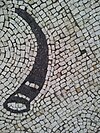
|
Represents the High Holy Days. Used as an instrument harkening in the new year in a ceremonial fashion. |
| Intermediate | ||
| Symbol | Image | History and usage |
| Star of David | 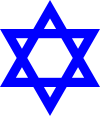
|
The Star of David, a symbol of Judaism as a religion, and of the Jewish people as a whole.[1] And it also thought to be the shield (or at least the emblem on it) of King David.
Jewish lore links the symbol to the "Seal of Solomon", the magical signet ring used by King Solomon to control demons and spirits. Jewish lore also links the symbol to a magic shield owned by King David that protected him from enemies. Following Jewish emancipation after the French revolution, Jewish communities chose the Star of David as their symbol. The star is found on the Flag of Israel. |
| Shin | 
|
Symbolizes El Shaddai (conventionally translated "God Almighty"), one of the Names of God in Judaism. This symbol is depicted on the ritual objects mezuzah and tefillin, and in the hand gesture of the Priestly Blessing. |
| Tablets of Stone | 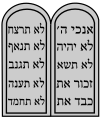
|
Represents the two tablets on which Moses inscribed the Ten Commandments at Mount Sinai. |
| Lion of Judah | 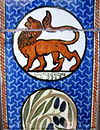
|
The Tanakh compares the tribes of Judah and Dan to lions: "Judah is a lion's whelp."[2]
Often a pair of lions appear as heraldic supporters, especially of the Tablets of Law. |
| Modern | ||
| Symbol | Image | History and usage |
| Chai (symbol) | 
|
"Alive" in Hebrew. |
| Hamsa | 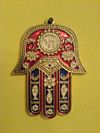
|
The Hamsa represents God's hand, in all faiths it is a protective sign. It brings its owner happiness, luck, health, and good fortune.[3] |
Shabbat and circumcision[]
| Part of a series on |
| Judaism |
|---|
   |
|
The Shabbat, according to Ezekiel 20:12 is God's sign ("ot") between Him and His people. It states, "Moreover also I gave them my shabbats, to be a sign between me and them, that they might know that I am the LORD that sanctify them." The Shabbat was instituted on the seventh day of creation for all mankind, and God did three things as our example in Genesis 2:1-3... 1) He rested from all work, 2) He blessed the Shabbat, and 3) God sanctified the seventh day, which means He set it apart for only Holy use. The ten commandments in Exodus 20:8-12 explain further that, "six days shall you labor and do all your work, but the seventh day is the Shabbat of the Lord your God, in that day you shall do no work".
The Tabernacle and the sacrifices[]
According to the Hebrew Bible, while the Israelites were living in the Sinai for forty years, they built a Tabernacle (Hebrew: משכן translit: mishkan, "Place of [Divine] dwelling"); this was viewed as the abode of the Shekhinah (the presence of YHWH) on Earth, and the place where the priests could minister to God on behalf of the nation of Israel.
The priests[]
The Hebrew for priest is Kohen; the Kohanim (plural) mediated between God and man by offering sacrifices, and by other services in the Temple. The leader of them the Kohen Gadol, the high priest.
The vestments of the high priest were interpreted in three ways. The explanation of Philo is as follows ("Vita Mosis," iii. 209): His upper garment was the symbol of the ether, while the blossoms represented the earth, the pomegranates typified running water, and the bells denoted the music of the water. The ephod corresponded to heaven, and the stones on both shoulders to the two hemispheres, one above and the other below the earth. The six names on each of the stones were the six signs of the zodiac, which were denoted also by the twelve names on the breastplate. The miter was the sign of the crown, which exalted the high priest above all earthly kings.
Josephus' explanation is this:[4] The coat was the symbol of the earth, the upper garment emblemized heaven, while the bells and pomegranates represented thunder and lightning. The ephod typified the four elements, and the interwoven gold denoted the glory of God. The breastplate was in the center of the ephod, as the earth formed the center of the universe; the girdle symbolized the ocean, the stones on the shoulders the sun and moon, and the jewels in the breastplate the twelve signs of the zodiac, while the miter was a token of heaven.
The Jerusalem Talmud[5] and Midrash Leviticus Rabbah (x.) give the following interpretation: The coat symbolized atonement for murder or for the sin of wearing mixed garments, and the undergarment typified atonement for unchastity. The miter denoted atonement for pride, and the belt for theft or trickery. The breastplate represented atonement for any perversion of the Law, the ephod for idolatry, and the robe for slander.
The symbolic values of numbers[]
The number three was the symbol of holiness and love. The Holy of Holies occupied one-third, and the Holy Place two-thirds, of the entire Temple. The tapestries were ten times three ells in length, and there were three vessels each for the altar of burnt offering, the altar of incense, and the Ark. The candlestick had twice three arms (besides the shaft, which also held a lamp), and each arm had three knobs. The blessing of the priest consisted of three sections,[6] and in the invocation of God the word "holy" was repeated thrice.
The symbolism of number four was based on the contemplation of the quaternity as found in the universe.[7] According to Ezekiel i. 26-28, the number four symbolized the divine revelation, while in the view of Philo it was the number of complete harmony.[8]
The number five typified semi completion. The dimensions of the curtain of the Holy of Holies were four ells by five; the altar in the court covered a surface of five square ells; and there were five pillars at the entrance to the Tabernacle.
The number six symbolizes imperfection.
The number seven was the general symbol for all association with God, and was the favorite religious number of Judaism, typifying the covenant of holiness and sanctification, and also all that was holy and sanctifying in purpose. The candlestick had seven lamps, and the acts of atonement and purification were accompanied by a sevenfold sprinkling. The establishment of the Sabbath, the Sabbatical year, and the year of jubilee was based on the number seven, as were the periods of purification and of mourning. The number 7 is the Divine number of completion.
The number eight symbolizes new beginnings. According to Kaballah in the Zohar the number eight signifies this because the eighth day was the first day after creation when God returned to work; the week began again.
The number ten symbolized absolute completeness. The court to the Tabernacle was ten times ten ells long, and five times ten ells wide, and in the Holy of Holies the Ten Commandments were preserved.
The number twelve, being the product of three and four, typified the union of the people with God.[9][10][11] On the table were twelve loaves of show-bread, and the breastplate of the priest contained twelve precious stones as emblems of the twelve tribes of Israel, which camped round about the Sanctuary.
The number thirteen symbolizes the principles of faith and God's mercy.
The number eighteen is considered significant because the Hebrew word for "life" is חי (chai), which has a numerical value of 18.
The number twenty six symbolizes God's name.
Metals and minerals[]
Gold was the symbol of the divine or celestial light, the glory of God.[12] Silver was the emblem of moral innocence and of holiness.[13] Brass symbolized hardness, strength, and firmness.[14] Brass was a substitute for gold, and iron for silver.[15]
Salt was declared to be necessary in every meal-offering, in which it takes the place of the blood in the animal sacrifices.[16] In the Talmud salt symbolizes the Torah, for as the world cannot exist without salt, so it can not endure without the Torah.[17]
Colors[]
The Israelites used a blue-colored dye called tekhelet; this dye was likely made from snail murex trunculus.[18] This dye was very important in both Jewish and non-Jewish cultures of this time, and was used by royalty and the upper-class in dyeing their clothing, sheets, curtains, etc. A similar dye was known as Tyrian purple.
In the Torah the Israelites are commanded to dye one of the threads of their tallit (prayer shawl) with tekhelet. Tekhelet corresponds to the color of the divine revelation (Midrash Numbers Rabbah xv.). Tekhelet in Judaism has thus had an important significance throughout the history of Jewish culture up to the present.
"Argaman" was the symbol of power, and of glory,[19] so that Alexander Balas robed Jonathan in purple,[20] which was especially used to designate royal dignity.[21]
"Tola'at" and "shani" ("scarlet," "crimson") symbolized blood, and thus frequently typified life, although this color often designated sin, as well as joy and happiness.[22]
Purification from sin was also symbolized by purple.[23]
"Shesh" (white) was the symbol of physical and intellectual purity, being the true color of light, without any modification.[24] White also symbolizes death in Judaism.
Yellow has an association with an anti-Semitic forced identification mark (see Yellow badge).
Festivals and holy days[]

The Torah delineates three pilgrimage festivals, Passover, Shavuot (The Feasts of Weeks) and Sukkot (Tabernacles). Each of these was tied to the agricultural cycle of the Israelites, and was also given a theological symbolism.
Passover celebrated the rebirth of nature, and symbolized the origin of the Jewish people.
The eating of bitter herbs symbolized the miseries of the Egyptian bondage. In the evenings four cups of wine were drunk, to symbolize the four world-kingdoms.[25] People eating during the Passover meal reclined, in the style of free rich aristocrats, to represent their liberation from slavery.
A discussion of the meaning of Shavuot (the Feast of Weeks) and of Sukkot, the Feast of Tabernacles, is found in the entries on those subjects.
A discussion of symbolism inherent in Rosh Hashanah (The New Year) and Yom Kippur (the Day of Atonement) is found in the entries on those subjects. The Day of Atonement was considered the most holy day of the entire year, and was regarded as the symbol of the complete atonement of the people and of their absolution from their sins committed against God.
Symbolic visions of the Prophets[]
Jeremiah beheld an almond-tree as a token of the speedy fulfillment of the word of God.
Amos saw a basket of summer fruit as a symbol of the approaching end of Israel.[26]
Ahijah the Shilonite tore Jeroboam's mantle into twelve pieces, to typify the division of the kingdom of Israel,[27] and Zedekiah made horns of iron to encourage Ahab to engage in war with Ramoth-gilead.[28] King Joash, at the command of the prophet Elisha, shot arrows from the open window into the air, to symbolize the destruction of his enemies.[29]
Isaiah walked naked and barefoot to show how the Egyptians and Ethiopians would be treated when taken captive by the Assyrians,[30] while Jeremiah wore a yoke upon his neck to induce the nations to submit to the King of Assyria.[31]
Ezekiel was commanded to inscribe the names of certain tribes upon separate pieces of wood, to show that God would reunite those tribes.[32]

On tombstones[]
Some common themes appear on many Jewish tombstones. Two hands with outspread fingers indicated that the dead man was descended from priestly stock (Kohanim) who blessed the people in this fashion, and a jug was carved on the tombstones of the Levites as an emblem of those who washed the priest's hands before he pronounced the blessing.
Some gravestones show a tree with branches either outspread or broken off, symbolizing the death of a young man or an old man respectively; or they have a cluster of grapes as an emblem of Israel.
The Star of David (Magen David) occurs frequently.
Sometimes figures symbolized the name of the deceased, as the figure of a lion for Loeb, a wolf for Benjamin, and a rose for the name Bluma/Blume.
Influence on Christian symbols[]
The influence of Judaism upon Christian symbolism as early as the 2nd and 3rd centuries A.D., is apparent both in painting and in sculpture, the most frequent motives being those that occur in the Mishnah as formulas for prayer on fast-days. The prayer beginning with the words "Mi she-'anah," which was included in the selihah at an early date, was adopted in the Christian ritual as the litany "Libera domine." This litany was figuratively used in a certain sequence as a symbol, for the sacrifice of Isaac was regarded as a symbol of the crucifixion of Jesus, since the early religions, and the act of sacrifice emblemized the death on the cross.
Abraham was represented as the symbol of the power of faith and Isaac as the sacrificed redeemer. The ascension of Elijah was believed to typify the ascension of Jesus Christ, who was regarded by Christian symbolism as an analogue to Elijah, although this ascension was also taken as a type of the general resurrection from the dead. Job sitting among the ashes was the symbol of patience and of the power of resistance of the flesh; and Hananiah, Mishael, and Azariah in the fiery furnace typified steadfastness in persecution and faith in the aid of God. Christian sarcophagi contained artistic representations of the fall of man, Noah and the ark, scenes from the life of Moses in three variations, Joshua, David, and Daniel.
The land of Zion[]
Zion is a Biblical term that refers to Jerusalem (and to some extent the whole Land of Israel), and is the source for the modern term Zionism. Mount Zion is a hill outside the walls of the Old City of Jerusalem, but the term previously referred to the Temple Mount, as well as a hill in the City of David.
Heraldry[]
Historically Jews who carried arms often use the iconography of the Lion of Judah, the Star of David, and if they were Kohens, the symbol of two hands performing the priestly benediction. However in recent years Jews granted armorial bearings often implement Zionistic symbolism.
See also[]
- Jewish services
- Menorah (Temple)
- Star of David
- Religious symbolism
- Ephod
- United States military chaplain symbols (includes history of Jewish Chaplain insignia)
- Winged sun § Hebrew
- Bar Kochba Revolt coinage
- Gematria
Notes[]
- ^ Yacov Newman, Gavriel Sivan, Judaism A-Z
- ^ Book of Genesis 49:9
- ^ The Encyclopedia of Jewish Symbols, page 70, Ellen Frankel, Betsy Platkin Teutsch. Rowman & Littlefield, 1992
- ^ "Ant." iii. 7, § 7
- ^ Menachot vii. 1
- ^ Num. vi. 24, 25
- ^ comp. Job xxxvii. I Copied from wikipedia3; Isa. xi. 12; Ezek. vii. 2; I Chron. ix. 24; Dan. viii. 8.
- ^ "De Opificio Mundi," pp. 13–15
- ^ Maude 1862: p. 509
- ^ 1 Kings 18:31–38
- ^ Genesis 32:24–30
- ^ Zech. vi. 11; Dan. xi. 21
- ^ Isa. i. 22; Jer. vi. 30
- ^ Lev. xxvi. 19; Jer. xv. 12; Job xl. 18
- ^ Isa. lx. 17
- ^ Lev. ii. 13; but comp. Ezek. xliii. 24
- ^ Soferim xv. 8
- ^ "Introduction to Tekhelet".
- ^ Isa. lx. 6; Judges viii. 26
- ^ I Macc. x. 20
- ^ I Macc. x. 20, xi. 58
- ^ Gen. xxxviii. 28; Josh. ii. 18, 21; Jer. iv. 30
- ^ Lev. xvi. 10
- ^ Cant. v. 10; Dan. iv. 10, 14, 20; Zech. xiv. 5
- ^ Talmud Yerushalmi Pesachim 37c; Midrash Gen. Rabbah lxxx
- ^ Amos viii. 1
- ^ I Kings xi. 30
- ^ I Kings xxii. 11
- ^ II Kings xiii. 15-19
- ^ Isa. xx. 2
- ^ Jer. xxvii. 2-4, 10-12
- ^ Ezek. xxxvii. 15
References[]
- Maude, Mary Fawler (1862). Scripture manners and customs. London: Society for Promoting Christian Knowledge. p. 600. ISBN 1-147-04502-X. Retrieved 2010-09-28.
External links[]
| Wikimedia Commons has media related to Jewish symbols. |
- Age of spirituality : late antique and early Christian art, third to seventh century from The Metropolitan Museum of Art
- Lions in Jewish art
- Jewish Heraldry
- Jewish art
- Jewish symbols
- Symbolism